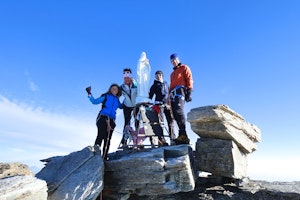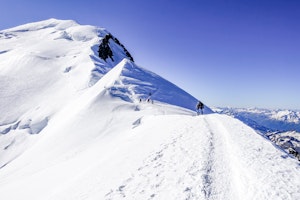Mountaineering (also referred to as ‘mountain climbing’ or ―mainly in Europe― ‘Alpinism’) is the sport of climbing a mountain.
Regardless of the length of the trip ―which can range from a few hours to multi-day expeditions―, mountaineering is more physically demanding than hiking. Mountains often provide a mixed terrain (with the presence of rock, ice and snow), so climbers need to be able to navigate through a wide variety of conditions. Depending on the case, mountaineering may involve using technical equipment and combining a series of related skills like scrambling, climbing, glacier travel, ice climbing, or mixed climbing.
Besides reaching a summit or completing a ridge traverse, the true success (and the main objective) of a mountaineering trip lies in overcoming safely every hazard along the route.
Want to get started with mountaineering? Read our list of 5 summits for beginners in the Alps
Most challenges in the mountain derive from the terrain’s characteristics: crevasses, avalanches, rockfall, glaciers, etc. High altitude (especially when attempting a peak over 4,000 meters) and adverse weather conditions are two other essential factors that may add difficulty to a mountaineering trip.
Other factors are directly related to mountaineers themselves, including their physical condition and acclimatization, technical skills, equipment, orientation, resourcefulness, and decision-making skills.
Mountaineering is mostly practiced in groups: teamwork and support are very important parts of the activity.
When is the best time of the year for a mountaineering trip?
The best conditions for a mountaineering trip are generally during Spring, early-Autumn, and Summer. These seasons provide more pleasant and stable weather conditions and allow mountaineers to avoid heavy snowfalls, extremely cold temperatures, and strong winds.

Mountaineering trip in the Ecuadorian Andes. Photo: Fredy Tipan.
Many mountains have a specific ‘peak season’: a time of the year when climbing is more popular. During peak season, all services on the mountain (mountain huts, gondolas) are fully functional, while most of them close in the off-season. Some routes are only open during the official climbing season as well. On the downside, climbing a popular mountain in peak season ―and especially during weekends or holidays― usually also implies more crowds.
Winter mountaineering is considered a more advanced stage in mountaineering, which requires specific equipment and more complete technical training. Winter conditions add technical difficulty to all mountain climbs. Besides, the risk of avalanches is bigger during this time of the year. Winter mountaineering is only recommended for mountaineers with previous experience.

Winter mountaineering in the German/Austrian Alps. Photo: Bernd Eberle.
What equipment do you need for mountaineering?
Mountaineering rope.
Harness designed for mountaineering.
Mountaineering helmet (to protect from rockfall).
Carabiners.
Belay devise.
Crevasse rescue equipment.
Mountaineering boots.
Camping items: 4-season tent, sleeping bag (check climate conditions), backpack.
Crampons.
Ice axes.
Mountaineering gloves.
Some guides who lead mountaineering trips include their clients’ necessary equipment in the price. However, in other cases, you will need to take your own equipment or rent it.
Why hiring a guide for a mountaineering trip?
Going on a mountaineering trip with a certified mountain guide is always highly recommended, both if you don’t have much experience in the mountains or if you want to accomplish more challenging goals. A certified guide usually knows the area very well, can handle the logistics of the trip and above all, is responsible for the group’s safety.

Mountain traverse in the Swiss Alps. Photo: Edward Bekker.
Here at Explore-Share.com, you’ll find many qualified mountain guides. Many of them are certified by the IFMGA (International Federation of Mountain Guides Associations) and were trained under the most rigorous international standards.
You can also check out mountaineering courses, which are designed either for beginners or advanced climbers. Taking a course is the best way of honing your skills on the terrain and learn from a professional guide!
5 Highly recommended courses for climbing a mountain
United States Mountaineering Skills course in the Cascades: 5 days of theory and practice for beginners capped with a Mount Baker or Mount Shuksan ascent led by one of the best climbing teams in the region.
Alpine Climbing course in the Canadian Rockies: Learn and practice mountaineering techniques in the scenic Columbia Icefields and Lake Louise region on this 6-day program for beginners led by Jeff’s amazing team of guides.
Mountaineering Course in Chamonix: A great option for beginners who want a tailored and personalized program in one of the world’s most popular mountaineering hotspots.
North Faces of the Alps intermediate mountaineering course:4 days of extensive hands-on training in the Alps with an expert guide is the best way to prepare for more ambitious ascents once you’ve mastered more basic climbs.
Himalayas 5 peak Training Course + Ama Dablam ascent: This advanced 1-month mountaineering program is a favorite among Explore-Share users with some mountaineering experience under the belt. If you’re just starting out, it should definitely be something to aspire to!
The world’s 10 best spots to practice mountaineering
1. French Alps. The cradle of alpinism boasts several classics, including the iconic Mont Blanc.
2. Cordillera Blanca, a stunning mountain range with many 4,000m summits, tucked deep in the Peruvian Andes.
3. Nepal, the ultimate goal for every mountaineer. Mountain expeditions to the summit of the imposing eight-thousanders of the Himalaya take several weeks and are definitely a once-in-a-lifetime experience!

Mountaineers on the summit of Matterhorn, Swiss Alps. Photo: Gauthier Poncelet.
4. The Swiss Alps: Jungfrau, the Monch, Eiger and, of course, the Matterhorn. These mountains are full of some of the big names in the mountaineering world.
5. Russia: mountaineering in the Caucasus Mountains should definitely be on your bucket list! Not only do they have Mt Elbrus, the highest peak in Europe, but also many other exciting mountains to climb.
6. The Kyrgyz mountains are still under the radar, but deserve a place on this list! From the easiest 7,000 m peak to climb, Lenin Peak, to the beautiful mountains of Ala Archa, this country is a mountaineering gem.
7. The Ecuadorian Andes provide mountain adventures for all levels! The highlights are the big volcanoes: Chimborazo (the highest peak in the country) and Cotopaxi.
8. Head to Argentina for two majestic summits that break all the records: Aconcagua, the roof of America and one of the Seven Summits; and Ojos del Salado, the highest volcano in the world at 6891 m.
9. The Japan Alps are a great mountaineering destination, especially for beginners or those who want to hone their skills to pursue bigger challenges.
10. Denali (6190 m), also known as Mount McKinley, is the highest peak in the United States and also one of the Seven Summits. It’s located in Alaska, very close to the Arctic Circle, so temperatures are below freezing!
Looking for some mountaineering options in South America? Don’t miss our recommendations for the top 5 peaks for beginners in the Andes.







